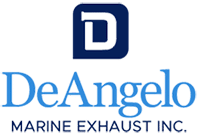Have you ever wondered why so many vessels in the marina have fuel and oil floating around them and a dark discoloration near the exhaust port on the side of the hull?
One of the most common issues is too much back pressure on the marine diesel engine or generator.
All engines and gensets are not alike – there are many different brands and models, and each has their own specifications for the air and water velocity. These variables will affect the mechanical design configuration of the route, length, and diameter for the exhaust system to meet the limitations of the back pressure specified by the engine manufacturer. Also, restrictions of the exhaust gas flow are increased by the addition of too many elbows, water mixer tanks, and mufflers. This will add to the back pressure problem, causing poor engine performance, economy, premature turbo wear, exhaust valves, and increased exhaust temperature.
Many times, we see that the piping and muffler is positioned below the waterline, which will allow water to accumulate, slowing down the velocity of the exhaust gases and increasing back pressure. Even the through-hull fitting can be too small or too far under the waterline, increasing back pressure. All this back pressure will decrease the time between engine overhauls, lower the combustion chamber temperature, and produce unburned hydrocarbons and soot expelled out of the boat and into the air, water, and on the hull.
Solution to Reducing Back Pressure
The solution to reducing the back pressure is to consider the manufacturer’s specifications, proper engineering, design, piping diameter and length dimensions – which minimizes elbows – keeping the exhaust system dry and above the waterline through risers to the water mixer tank just before a good flowing muffler, and the position of the through-hull connection.
In addition to proper exhaust system design, working with a well-known marine diesel exhaust manufacturing company is a huge benefit.
Things to look out for are in-house engineering, quality practices such as certified welders and fabricators, pressure testing of all systems, passivation of the metal to ensure longevity, hard coat and/or blanket insulation to reduce engine room temperatures, and highly experienced mobile service teams. These factors guarantee not only a correctly designed exhaust system, but also minimal down time and a properly installed system that will last for many years.
Diesel Particulate Filter (DPF)
If after having the exhaust system checked for back pressure and it’s within limits, or after replacing the exhaust system and soot still occurs on the hull, then the next best solution is to consider adding a Diesel Particulate Filter (DPF) to the exhaust system. These systems will burn off the particulates after the turbo, catch the ash in the filter, and then catalyze the ash and expel water vapor out to the atmosphere.
Author Mike Prado
Mike Prado is the VP of business development for DeAngelo Marine Exhaust, manufacturer of marine exhaust systems, parts, and services.
Original Article: Dockwalk Tech Talk Engineering | June 2019
http://viewer.zmags.com/publication/bc71ff2a#/bc71ff2a/47
Dockwalk is the essential magazine and website for superyacht captains and crew.
 Contact DeAngelo Marine if you require an inspection / survey of your engine room, main engines or generator exhaust systems. We invite your inquiry for exhaust parts & accessories and exhaust repairs and service with your existing vessel. If you are in the design phase of new vessel construction or contemplating an engine overhaul, contact DeAngelo Marine Exhaust by email or by telephone: +1 954.763.3005.
Contact DeAngelo Marine if you require an inspection / survey of your engine room, main engines or generator exhaust systems. We invite your inquiry for exhaust parts & accessories and exhaust repairs and service with your existing vessel. If you are in the design phase of new vessel construction or contemplating an engine overhaul, contact DeAngelo Marine Exhaust by email or by telephone: +1 954.763.3005.

